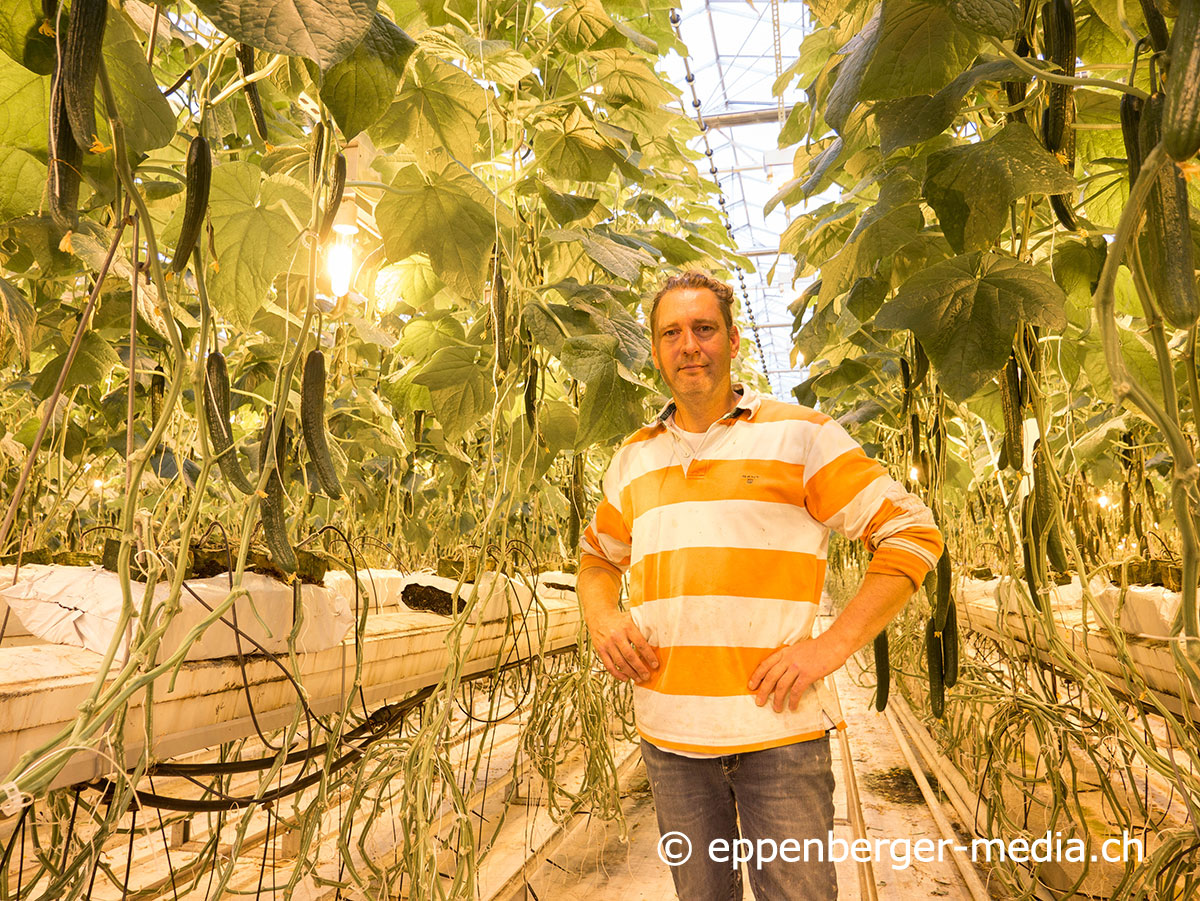
Despite short days and minus temperatures, the Finnish vegetable gardeners produce cucumbers in the greenhouses in winter. They are much more expensive than imported goods, but they are still preferred by Finnish consumers.
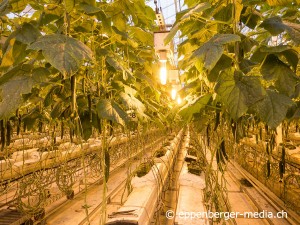 Finnish summers are short, the winters all the longer, cold and dark. In January there are just four hours of daylight. Ideal cultivation conditions for cucumbers look different. This does not concern the Finnish vegetable gardeners, however. They produce cucumbers and tomatoes in their greenhouses even in the deepest winter. The state supports the year-round production with a contribution of EUR 9 per square meter, with additional EU subsidies. The self-supply rates are surprisingly high with 80% for cucumbers and 60% for tomatoes. Finns consistently buy goods from local production, even if they are significantly more expensive than imported goods from Spain or Holland. The PR departments of the cultivation associations obviously did a great job here: the image of Finnish vegetables is extremely good in the population, the support of the regional production is correspondingly high. The local vegetables are considered the best in the world in Finland. According to Tom Murman, who worked for many years as a consultant to the Finnish Glasshouse Growers‘ Association, before he was retired, Imported goods tend to deteriorate significantly in residue analyzes. But not just that: „The freshness is the decisive factor when it comes to cucumbers,“ says Tom Murman. Finland is far away from the rest of Europe and the transport of Spanish cucumbers takes five days. The from the Finnish greenhouse create it in one day.
Finnish summers are short, the winters all the longer, cold and dark. In January there are just four hours of daylight. Ideal cultivation conditions for cucumbers look different. This does not concern the Finnish vegetable gardeners, however. They produce cucumbers and tomatoes in their greenhouses even in the deepest winter. The state supports the year-round production with a contribution of EUR 9 per square meter, with additional EU subsidies. The self-supply rates are surprisingly high with 80% for cucumbers and 60% for tomatoes. Finns consistently buy goods from local production, even if they are significantly more expensive than imported goods from Spain or Holland. The PR departments of the cultivation associations obviously did a great job here: the image of Finnish vegetables is extremely good in the population, the support of the regional production is correspondingly high. The local vegetables are considered the best in the world in Finland. According to Tom Murman, who worked for many years as a consultant to the Finnish Glasshouse Growers‘ Association, before he was retired, Imported goods tend to deteriorate significantly in residue analyzes. But not just that: „The freshness is the decisive factor when it comes to cucumbers,“ says Tom Murman. Finland is far away from the rest of Europe and the transport of Spanish cucumbers takes five days. The from the Finnish greenhouse create it in one day.
20 hours of light in winter
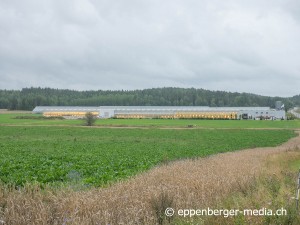
The cucumber greenhouse of Tero Juntti in Piikkiö near Turku is brightly lit. The lighting of the lamps between and above the cultivation series is necessary, since the incidence of light from outside is too small for most of the year. In winter it is close to zero and the outside temperatures are in the double-digit minus range. The high-pressure sodium lamps then burn for 20 hours and ensure that the market is supplied with Finnish cucumbers in winter to around 50 percent. With the radiated heat, the lamps contribute significantly to the necessary indoor temperature of 25 degrees. The electricity prices are therefore much more decisive than the gas or oil prices for the calculation of the production costs for the cucumber cultivator. In addition to 70 tonnes of liquefied petroleum gas, including CO2 fertilization, he needs 17 million kilowatt-hours of electricity per year for the greenhouse area of 1.25 hectares. Like Tero Juntti produces about half of all Finnish cucumber producers all year. The total cucumber cultivation area in Finland is 52 hectares.
Price pressure also in Finland
Due to the high production costs, the Finnish cucumber producers are dependent on corresponding acceptance prices. But these also occasionally stumble here: this summer the production surpassed the demand despite a particularly dull summer even for Finnish conditions. The price of kilograms decreased for Tero Juntti to under 60 Eurocent. Usually it is in the summer with up to 2 euros. In winter, however, the price is usually much more than 2 euros. „We need at least so much to meet production costs,“ says Tero Juntti. The margin is nevertheless still low: some of his colleagues have failed.
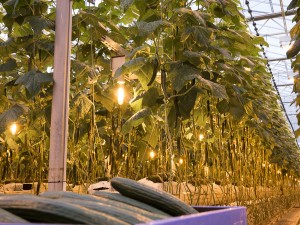
The vegetable gardener plants new cucumbers three times a year. They are growing this year in a substrate made of a mixture of coconut fibers and peat. However, he dragged an unwanted spider over the substrate. In the future, he will also be relying on a new mixture of peat and moss, which has proved successful in cultivation experiments.
Plant protection is primarily integrated and beneficial. The workers, mainly from Vietnam, are harvesting up to 200 kilograms of cucumbers per square meter and year under lighting of up to 350 watts under the direction of the Finnish foreman.
Waterfalls collect heat
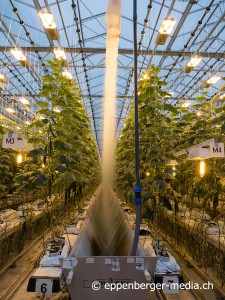
In addition to the labor costs – the minimum wage is according to the greenhouse producer association at 8.50 euros per hour -, the energy costs affect the operating account. The kilowatt-hour price for electricity also varies depending on the season between 5 and 8.5 Eurocent. The industry is therefore working on efficiency not just for ecological reasons. At Tero Junnti, for example, several artificial waterfalls patter between the rows of cucumbers. The water droplets collect the heat emitted by the lamps. A heat pump uses the temperature difference of four degrees in the water and returns it as a heating energy back into the greenhouse. „So I can generate more than half of the heat,“ says Tero Junnti. Many cucumber producers also experiment with LED lamps that consume less energy. However, there is also a lack of heat. „The future will therefore probably lie in hybrid solutions,“ says Tom Murman, a glass expert.
Cucumbers have been growing all year round in Finnish greenhouses for over twenty years. During this time the production grew from 27 to about 40 million kilos per year. The energy consumption is high: according to the association, it was an average of 15 kilowatt hours per kilogram of greenhouse vegetables in 2008, and still consists primarily of electricity, one third of which is generated from fossil fuels, nuclear power and renewable energies such as hydropower. In order to improve the ecological footprint, according to the association, in the last few years many greenhouse producers had switched to wood-chip heating systems. This makes sense: Finland consists of over 70 per cent of forest, which forms more biomass than it is taken from it.
Peat in the heating
For Western Europeans in particular, the fact is that in about 15 percent of the Finnish greenhouses for the heat recovery still peat is burnt. In Finland, the controversial peat discussion is relatively relaxed. Around one third of the country consists of marshes which form 40 million cubic meters of peat a year, writes the Finnish agricultural journalist Tapani Koivunen. Less than one per cent of the gate area is harvested annually and used as an energy carrier or planting medium.
Tero Juntti uses peat in itself but only in the substrate. Over the next few years, he is optimistic about price pressure: „If the quality is right, the Finns will continue to buy our slightly more expensive cucumbers!“.
it beneficial. The workers, mainly from Vietnam, are harvesting up to 200 kilograms of cucumbers per square meter and year under lighting of up to 350 watts under the direction of the Finnish foreman.
Numbers about Finland |
| Population: 5,5 millions |
| Average temperatures in Helsinki: 4.4 degrees (spring) / 16.3 degrees (summer) /6.8 degrees (autumn) / -3.4 degrees (winter) |
| Total agricultural area (without forest): 2.3 million ha |
| Greenhouse area (vegetables and flowers): 399 ha |
| Vegetables in the field: approx. 10’300 ha |
| Tomatoes (2015) per year: 39 million kg |
| Cucumbers (2015) per year: 40 million kg |
| Carrots (2015) per year: 64 million kg |
| Onions (2015) per year: 27 million kg |
| Self-sufficiency level (2015): tomatoes 60% / cucumbers 80% / carrots 90% / onions 66% / cauliflower 82% (2014) / green salad 95% |

Kommentare